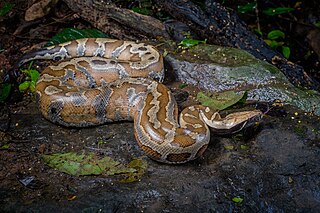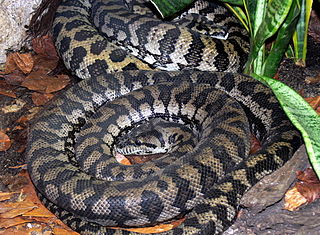
Antaresia is a genus of pythons, nonvenomous snakes in the family Pythonidae. The genus is native to Australasia. The genus is known by the common name Children's pythons, the name of the type species, Antaresia childreni. Gray named A. childreni in honour of his mentor, John George Children, who was a curator of the zoological collection at the British Museum around that time. It contains the smallest members of the Pythonidae. Four species and two subspecies are recognized, although they were all considered part of the same species until recently. A newly described form called the pygmy banded python may be a distinct species, but analysis has not yet been performed on this animal. The largest recorded examples of Antaresia species have all been males, suggesting males of the known species in this genus may compete for females. This behavior has never been witnessed in the wild, and has only been witnessed in captive specimens.

Leiopython is a genus of snakes in the family Pythonidae.

Xenopeltis, the sunbeam snakes, are the sole genus of the monotypic family Xenopeltidae, the species of which are found in Southeast Asia. Sunbeam snakes are known for their highly iridescent scales. Three species are recognized, each one with no subspecies. Studies of DNA suggest that the xenopeltids are most closely related to the Mexican burrowing python and to the true pythons (Pythonidae).

The green tree python, also known as the emerald green python, is a species of snake in the family Pythonidae. The species is native to New Guinea, some islands in Indonesia, and the Cape York Peninsula in Australia. First described by Hermann Schlegel in 1872, it was known for many years as Chondropython viridis. As its common name suggests, it is a bright green snake that can reach a total length of 2 m (6.6 ft) and a weight of 1.6 kg (3.5 lb), with females slightly larger and heavier than males. Living generally in trees, the green tree python mainly hunts and eats small reptiles and mammals. It is a popular pet, and numbers in the wild have suffered with large-scale smuggling of wild-caught green tree pythons in Indonesia. Despite this, the green tree python is rated as least concern on the IUCN Red List of endangered species.

Morelia spilota, commonly known as the carpet python, is a large snake of the family Pythonidae found in Australia, New Guinea, Bismarck Archipelago, and the northern Solomon Islands. Many subspecies are recognised; ITIS lists six, the Reptile Database six, and the IUCN eight.

Children's python is a species of nonvenomous snake in the family Pythonidae. The species is named after John George Children. It is a nocturnal species occurring in the northern half of Australia and generally found on the ground, although it often climbs trees. Usually growing to about 1.0 m (3 ft) in length or more depending on the polymorphic variant, it is typically a reddish-brown colour, darker on the upper surface, and with many darker blotches, especially on younger specimens. The Stimson's python variant has much stronger and more variable colours; often being adorned with reddish-brown to chocolate blotches against lighter tan. It feeds mostly on small mammals and birds, and as with other pythons, it constricts its prey before swallowing it whole. It is a popular pet among reptile enthusiasts.

Simalia boeleni is a species of python, a nonvenomous snake in the family Pythonidae. The species is endemic to the mountains of New Guinea. No subspecies are recognized. Its common names include Boelen's python and the black python.

Apodora papuana is a species of python, commonly known as the Papuan python, Irian python or Papuan olive python. It is found in New Guinea. It is the only species in the genus Apodora. No subspecies are currently recognized.

The amethystine python, also known as the scrub python or sanca permata in Indonesian, is a species of non-venomous snake in the family Pythonidae. The species is found in Indonesia and Papua New Guinea. Popular among reptile enthusiasts, and noted for its coloration and size, it is one of the largest snakes in the world, as measured either by length or weight, and is the largest native snake in Papua New Guinea. Until 2000, the larger S. kinghorni was generally considered a subspecies of S. amethistina, and this change of classification has still not been universally reflected in literature. Because of this issue, S. amethistina has often been described as the largest snake in Australia, but this is not accurate since under the current classification, this species does not occur in Australia.

The Oenpelli python or Oenpelli rock python is a species of large snake in the family Pythonidae. The species is endemic to the sandstone massif area of the western Arnhem Land region in the Northern Territory of Australia. There are no subspecies that are recognised as being valid. It has been called the rarest python in the world. Two notable characteristics of the species are the unusually large size of its eggs and its ability to change colour.

The pygmy python, also known as the anthill python, is a species of snake found in Western Australia. Their common names refer to the fact that they are the smallest member of the family Pythonidae and are often found in termite mounds. The specific epithet is derived from the state capital, Perth, despite the fact that this place is not within the range of the species. No subspecies are currently recognized.

Python brongersmai is a species of nonvenomous snake in the family Pythonidae. The species is native to Southeast Asia.

Morelia spilota spilota is a subspecies of carpet python, popularly known as the diamond python. It is a medium to large snake, found in coastal areas and adjacent ranges of south-eastern Australia. It is the most southerly occurring python in the world and is found at higher altitudes than any other species of Australian python.

The Timor python is a python species found in Southeast Asia. A dwarf species, no subspecies are recognized as being valid. Like all pythons, it is a nonvenomous constrictor; unlike larger species such as the reticulated python, it is not considered dangerous to humans.

Morelia spilota variegata, commonly known as Torresian carpet python, Darwin carpet python or northwestern carpet python, is a subspecies of python found in New Guinea and Australia, smaller than the nominate subspecies Morelia spilota spilota and has a more restricted geographic range.

Simalia tracyae, the Halmahera python, is a species of python found only on the Indonesian island of Halmahera. It belongs to the family Pythonidae and the genus Simalia. This snake was previously believed to have belonged to the Simalia amesthistina species; however, studies in recent years have caused scientists to distinguish between the two types of snakes, resulting in the reclassification of the Halmahera python as its own species.

The Australian scrub python, or simply scrub python is a species of snake in the family Pythonidae. The species is indigenous to forests of northern Australia. It is one of the world's longest and largest snakes, and is the longest and largest in Australia. Recently, it has been reclassified to the genus Simalia alongside a few other former Morelia species, but scientific debate over this continues.

D'Albertis' python, also known commonly as D'Albert's water python or the northern white-lipped python, is a species of python, a non-venomous snake in the family Pythonidae. The species is endemic to New Guinea. There are no subspecies that are recognized as being valid.
Leiopython fredparkeri, the Karimui Basin whitelip python or Karimui Basin white-lipped python, is a species of snake in the family Pythonidae. It is endemic to New Guinea. It was first described by Wulf Schleip in 2008.



















